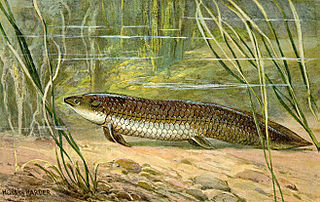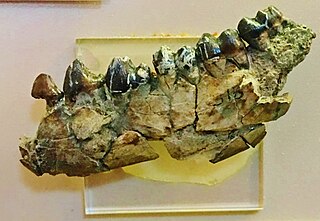
The Phascolarctidae is a family of marsupials of the order Diprotodontia, consisting of only one extant species, the koala, and six well-known fossil species, with another six less well known fossil species, and two fossil species of the genus Koobor, whose taxonomy is debatable but are placed in this group. The closest relatives of the Phascolarctidae are the wombats, which comprise the family Vombatidae.

Ailuravus is a genus of prehistoric rodents in the family Ischyromyidae.
Pachycetus is a genus of basilosaurine basilosaurid from Middle Eocene (Bartonian) of the eastern United States, and Ukraine.

Ceratodus is an extinct genus of lungfish. It has been described as a "catch all", and a "form genus" used to refer to the remains of a variety of lungfish belonging to the extinct family Ceratodontidae. Fossil evidence dates back to the Early Triassic. A wide range of fossil species from different time periods have been found around the world in places such as the United States, Argentina, Greenland, England, Germany, Egypt, Madagascar, China, and Australia. Ceratodus is believed to have become extinct sometime around the beginning of the Eocene Epoch.

Batrachiderpeton is an extinct genus of nectridean lepospondyl within the family Diplocaulidae; it was a basal member of the family. The type species is B. reticulatum and was found in a coal field in Northumberland, England at a locality that also yields the remains of Anthracosaurus russelli. A second species is also known: B. lineatum.

Litokoala is an extinct genus of marsupials, and along with Nimiokoala, is closely related to the modern koala. The three genera may have diverged at an earlier date, although the drying of the continent and the expansion of Eucalyptus forests towards the late Miocene may have delayed the evolution of cranial features unique to the modern genera. This indicates that either fossil genus could be an ancestor of the modern genus, or the modern genus has a common ancestor to both. More material needs collection to improve their taxonomical relationships.
Latentemys is an extinct genus of podocnemidid turtle. It is known from Miocene aged sediments of the Moghara Formation in Egypt.
Ngapakaldia is an extinct genus of diprotodontid marsupials, related to the modern koala and wombat. Around the size of a sheep, it was a ground-dwelling herbivore that lived around the vegetated shores of lakes in Central Australia during the Late Oligocene.

Colubroidea is a superfamily of snakes in the clade Colubroides that includes Colubridae, with some studies splitting Colubridae into multiple families that make up Colubroidea. Historically, Colubroidea also included other caenophidian snakes such as cobras and vipers, as these snakes form a clade. However these groups are now divided into several distinct, but related, families. Zaher et al. (2009) proposed to redefine Colubroidea for colubrids and related families, while designating Colubroides as the group containing vipers and cobras as well as colubroids. The ReptileDatabase considers Colubroidea to be composed of Colubridae and the members of its sister group, Elapoidea, and does not recognize the division of Colubridae into multiple families.
Doliognathus is an extinct genus of conodonts in the family Bactrognathidae from the Middle Dinantian. It is a genus of multielement conodonts.
Amorphognathus is an extinct conodont genus in the family Balognathidae from the Ordovician.
Sweetognathus is an extinct genus of conodonts in the family Sweetognathidae that evolved at the beginning of the Permian period, in near-equatorial, shallow-water seas.

Tetraclaenodon was a genus of small and early ungulate mammals that was part of the Phenacodontidae family.
Cancelloceras is an extinct genus of ammonites in the family Gastrioceratidae. Species are from the Carboniferous.
Hardistiella montanensis is a fossil fish and extinct species of lamprey found, dating from the Carboniferous period, at the Bear Gulch Limestone site in the U.S. state of Montana.
Palaeophasianus is an extinct genus of flightless Geranoididae birds that lived in North America during the Eocene period. Robert Wilson Shufeldt classified Palaeophasianus as a galliform when he described it in 1913. However it was transferred to Cracidae in 1964 by Pierce Brodkorb, while Joel Cracraft in 1968 placed it in Gruiformes.
Dorcopsoides is a genus of extinct species of kangaroo from the Pliocene of Australia.
Madakoala is a genus of extinct phascolarctid marsupials with three known species, Madakoala devisi,Madakoala wellsiandMadakoala robustus. It is allied to extinct genera Invictokoala, Koobor, Litokoala, Nimiokoala, Perikoala, Phascolarctos and Priscakoala, along with Phascolarctos, the genus of the existing koala. Madakoala went extinct around 280,000 years ago in the Pleistocene epoch. They are known to exist by limited cranial material in fossils, so the existence of some of the subspecies is questionable because of missing dental data.

Kalligramma is a prehistoric genus of winged insects in the family Kalligrammatidae.
Bubodens magnus is an poorly understood, extinct multituberculate mammal from the Upper Cretaceous of South Dakota. It is known only from a single tooth, and has uncertain placement within the suborder Cimolodonta though has been tentatively argued to belong to Taeniolabidoidea. This species is the only known member of the genus Bubodens, and may have been the largest known mammal of the Cretaceous.








